Submitted:
01 March 2024
Posted:
04 March 2024
You are already at the latest version
Abstract
Keywords:
1. Introduction
2. Materials and Methods
2.1. Research Area
2.2. Materials
2.2.1. DJI Phantom 4 Multispectral
2.2.2. DJI Mavic 2 Enterprise Advance Thermal
2.3. Methodology
2.3.1. Pre-Planning of the Flights
2.3.2. Preparation of Drone Flights
2.3.3. Drone Flights
2.3.4. Post-Processing
3. Results
- -
- individual images,
- -
- orthophoto map,
- -
- calculated vegetation indices on the basis of multispectral drone flights,
- -
- thermal orthophoto map,
- -
- digital terrain model (DTM),
- -
- digital surface model (DSM).
3.1. Updating and Revising Land Classifications
- -
- Vegetation,
- -
- Grass,
- -
- Shrub,
- -
- Hardwood,
- -
- Street,
- -
- Water.
3.2. Identification of Water Surfaces and Coastline
3.3. Identification of Flowing Water on the Basis Thermal Orthophoto
4. Discussion
- -
- Slope map, which illustrates the terrain’s slope, can be utilized to calculate rainfall-runoff, aiding in the development of flood control programs,
- -
- Exposure map, facilitating the examination of sunlight impact in specific areas,
- -
- Visibility map, applicable in constructing observation towers for forestry and tourism, serving as viewpoints.
5. Conclusions
- -
- State of vitality and changes of vegetation, using vegetation indicators based on data obtained from a multispectral camera
- o
- Verification and identification of vegetation types using machine learning algorithms - supervised classification
- -
- Identification of water surfaces and detection coastline of water reservoirs
- -
- Identification of the temperature of water surfaces and terrain using a thermal camera
- -
- Creating digital terrain models to visualize the research area
Author Contributions
Funding
Data Availability Statement
Acknowledgments
Conflicts of Interest
References
- Spreckels, V.; Vosen, P.; Busch, W.; Fischer, C.; Matejka, H. Einsatz von Photogrammetrie, Fernerkundung und GIS im Umwelt monitoring der Deutsche Steinkohle AG. Markscheidewesen 2006, 113, 3, pp. 95 -113. 3.
- Kretschmann, J. The sustainable development strategy of the German hard coal mining industry. In Proceedings of the 7th Sustainable Development in the Minerals Industry Conference (SDIMI), University of British Columbia, Vancouver, Canada, 13 July 2015. [Google Scholar]
- Kratzsch, H. Bergschadenkunde. 4. Auflage; Deutscher Markscheider-Verein e.V.: Bochum, Germany, 2005; p. 894. [Google Scholar]
- Kłeczek, Z. Geomechanika Górnicza. Śląskie Wydawnictwo Techniczne: Katowice, 1994, pp.198.
- Keinhorst, H. Die Berechnung der Bodensenkungen im Emschergebiet, Festschrift 25 Jahre Emschergenossenschaft: Essen, 1925.
- Bals, R. Beitrag zur Frage der Vorausberechnung bergbaulicher Senkungen. Mitteilungen aus dem Markscheidewesen 1931/32, Jg. 42/43, pp. 98-111. /43.
- Lehmann, K.; Neubert, K.; Schafstein, K. Berechnung und Darstellung von Bodenbewegungen über Abbauen. Mitteilungen aus dem Markscheidewesen 1942. [Google Scholar]
- Awershin, S.G. Сдвижение гoрных пoрoд при пoдземных разрабoтках, Ugletekhizdat: Moscow, 1947, p.245.
- Sann, B. Betrachtungen zur Vorausberechnung von Bodensenkungen infolge Kohenabbaus. Bergbau-Rundschau 1949, 163-167.
- Knothe, S.; Równanie profilu ostatecznie wykształconej niecki osiadania, Archiwum Górnictwa i Hutnictwa 1953, Tom 1, Zeszyt 1, pp. 111-127.
- Litwiszyn, J. Statistical methods in the mechanics of granular bodies. Rheologica Acta 1958, 1, pp. 146–150.
- Berry, D.S. Ground movement considered as an elastic phenomenon, Min. Engr. 1963, 123 (37), pp. 28–41.
- Sashurin, A. D. Сдвижение гoрных пoрoд на рудниках чернoй металлургии. IGD Ural: Yekaterinburg, 1999, p. 262.
- Busch, W.; Yin, X.; Coldewey, W.G.; Hejmanowski, R. Bergwerk Ost der RAG AG. Analyse von Senkungserscheinungen außerhalb des prognostizierten Einwirkungsbereiches. Gutachten im Auftrag der Bezirksregierung Arnsberg. Institut für Geotechnik und Markscheidewesen, TU Clausthal: Clausthal-Zellerfeld, Germany, 2017.
- Busch, W.; Walter, D.; Yin, X.; Coldewey, W.G.; Hejmanowski, R. Bergwerk Lippe der RAG AG. Analyse von Senkungserscheinungen außerhalb des prognostizierten Einwirkungsbereiches. Gutachten im Auftrag der Bezirksregierung Arnsberg. Institut für Geotechnik und Markscheidewesen, TU Clausthal: Clausthal-Zellerfeld, Germany, 2017.
- Busch, W.; Walter, D.; Coldewey, W.G.; Hejmanowski, R. Bergwerk Lohberg/Osterfeld der RAG AG. Analyse von Senkungserscheinungen außerhalb des prognostizierten Einwirkungsbereiches. Gutachten im Auftrag der Bezirksregierung Arnsberg. Institut für Geotechnik und Markscheidewesen, TU Clausthal: Clausthal-Zellerfeld, Germany, 2017.
- Suchowerska Iwaniec, A.M.; Carter, J.P.; Hambleton, J.P. Geomechanics of subsidence above single and multi-seam coal mining. J. Rock Mech. Geotech. Eng. 2016, 8, 304–313. [Google Scholar] [CrossRef]
- Xia, K.; Chen, C.; Liu, X.; Fu, H.; Pan, Y.; Deng, Y. Mining-induced ground movement in tectonic stress metal mines:a case study. Bull. Eng. Geol. Environ. 2016, 75, 1089–1115. [Google Scholar] [CrossRef]
- Xia, K-z; Chen, C-x.; Liu, X-m.; Zheng, Y.; Fu, H. Ground movement mechanism in tectonic stress metal mineswith steep structure planes. J. Cent. South Univ. 2017, 24, 2092–2104. [CrossRef]
- Tan, Q.L.; Xie, C. Preliminary Result of Permafrost Roadbed Settlement Measurement Using Satellite D-InSAR Technology. Appl. Mech. Mater. 2011, Vols. 105–107, 1912–1915. [CrossRef]
- Sheng, Y.B.; Shen Y.; Xu, S. Environmental Impact Evaluation of Underground Mining Activities Using InSAR Technique. Adv. Mater. Res. 2014, 1073–1076, 1907–1910. 1076. [CrossRef]
- Liu X,;Wang, Y.; Yan, S.; Shao, Y.; Zhou, H.; Li, Y. Ground subsidence characteristics associated with urbanization in East China analyzed with a Sentinel-1A-based InSAR time series approach. Bull. Eng. Geol. Environ. 2018, 78, 4003–4015. 4015. [CrossRef]
- Zheng, L.; Zhu, L.; Wang, W.; Guo, L.; Chen, B. Land Subsidence Related to Coal Mining in China Revealed by L-band InSAR Analysis. Int. J. Environ. Res. Public Health 2020, 17, 1170. [Google Scholar] [CrossRef] [PubMed]
- Zhang, B.; Wu, S.; Ding, X.; Wang, C.; Zhu, J.; Li, Q. Use of Multiplatform SAR Imagery in Mining Deformation Monitoring with Dense Vegetation Coverage: A Case Study in the Fengfeng Mining Area, China. Remote Sens. 2021, 13, 3091. [Google Scholar] [CrossRef]
- Kadlečík, P.; Kajzar, V.; Nekvasilová, Z.; Wegmüller, U.; Doležalová, H. Evaluation of the subsidence based on dInSAR and GPS measurements near Karviná, Czech Republic. Acta Univ. Carolinae. Geographica. Univerzita Karlov. 2015, 50, 51–61. [Google Scholar] [CrossRef]
- Marschalko, M.; Yilmaz, I.; Lamich, D. Drusa, M.; Kubečková, D., Peňaz, T.; Burkotová, T.; Slivka, V.; Bednárik, M.; Krčmář, D.; Duraj, M.; Sochorková, A. (2014). Unique documentation, analysis of origin and development of an undrained depression in a subsidence basin caused by underground coal mining (Koziniec, Czech Republic). Environ. Earth Sci. 2014, 72, pp.11-20. [CrossRef]
- Spreckels, V.; Walter, D.; Wegmueller, U.; Deutschmann, J.; Busch, W. Nutzung der Radarinterferometrie im Steinkohlenbergbau. Allg. Vermess. -Nachrichten (AVN) 2008. 7/2008, 253-261. 2008.
- Spreckels, V.; Walter, D.; Kamphans, K.; Busch, W. Einsatz der Radarinterferometrie im Rahmen eines GIS-basierten Monitoringsystems zur Analyse bergbaulicher Bodenbewegungen. In Proceedings of the 9. Geokinematischer Tag, Freiberg, Germany, 8–9 May 2008. [Google Scholar]
- Schäfer, M.; Walter, D.; Busch, W. DInSAR ground movement monitoring in the rural environment of an open pit mining area. In Proceedings of the ENVISAT Symposium, Montreux, Switzerland, 23–27 April 2007. [Google Scholar]
- Schäfer, M.; Hannemann, W.; Busch, W. Mining related ground movement detection by combination of multi-temporal and multi-sensoral DInSAR and PSI analyses. In Proceedings of the 4. TerraSAR-X Science Team Meeting, Oberpfaffenhofen, Germany; 14-16.02.2011. [Google Scholar]
- Ashrafianfar, N.; Busch, W.; Dehghani, M.; Haghighatmehr, P. Differential SAR interferometric technique for land subsidence monitoring due to groundwater over-exploration in the Hashtgerd, In Proceedings of ‘Fringe 2009 Workshop’, Frascati, Italy, 30 November–4 December 2009.
- Ashrafianfar, N.; Hebel, H.-P.; Busch, W. Monitoring of mining induced land subsidence – differential SAR interferometry and persistent scatterer interferometry using TERRASAR-X data in comparison with ENVISAT data. In Proceedings of the 4th TerraSAR-X Science Team Meeting, Oberpfaffenhofen, Germany, 14–16 February 2011. [Google Scholar]
- Busch, W.; Coldewey, W.G.; Walter, D.; Wesche, D.; Tielmann, I. Analyse von Senkungserscheinungen außerhalb prognostizierter bergbaulicher Einwirkungsbereiche des Bergwerks Prosper-Haniel. Gutachten der TU Clausthal und der WWU Münster vom 31.08.2012 im Auftrag der Bezirksregierung Arnsberg (Abt.6): Clausthal-Zellerfeld, Germany, 2012.
- Beyene, F.; Knospe, S.; Busch, W. Enhancing DInSAR capabilities for landslide monitoring by applying GIS-based multicriteria filtering analysis. In Proceedings of the 36th International Symposium on Remote Sensing of Environment, Berlin, Germany, 11–15 May 2015. [Google Scholar]
- Goerke-Mallet, P.; Busch, W.; Müterthies, A.; Melchers, C. Copernicus for Mining – über den Einsatz von Sentinel-Daten im Nachbergbau. BHM Berg-Und Hüttenmännische Monatshefte 2017, 162, 427-429. [CrossRef]
- Blachowski, J.; Milczarek, W. Analysis of surface changes in the Walbrzych hard coal mining grounds (SW Poland) between 1886 and 2009. Geol. Q. 2014, 58, 353–368. [Google Scholar] [CrossRef]
- Blachowski, J. Application of GIS spatial regression methods in assessment of land subsidence in complicated mining conditions: case study of the Walbrzych coal mine (SW Poland). Nat. Hazards 2016, 84, 997–1014. [Google Scholar] [CrossRef]
- Milczarek, W.; Blachowski, J.; Grzempowski, P. Application of PSInSAR for assessment of surface deformations in post_mining area - case study of the former Walbrzych Hard Coal Basin (SW Poland). Acta Geodyn. Et Geomater. 2017, 14, 41–52. [Google Scholar] [CrossRef]
- Milczarek, W.; Blachowski, J.; Kopeć, A.; Owczarz, K. Evolution of Secondary Deformations Captured by Satellite Radar Interferometry: Case Study of an Abandoned Coal Basin in SW Poland. Sustainability 2019, 11, 884. [Google Scholar] [CrossRef]
- Malinowska, A.; Witkowski, W.T.; Guzy, A.; Hejmanowski, R. Satellite-Based Monitoring and Modeling of Ground Movements Caused by Water Rebound. Remote Sens. 2020, 12, 1786. [Google Scholar] [CrossRef]
- Owczarz, K.; Blachowski, J. ANALYSIS OF THE GEOMETRY OF SURFACE DEFORMATIONS CAUSED BY INDUCED TREMORS IN THE AREA OF UNDERGROUND COPPER MINING. ISPRS Ann. Photogramm. Remote Sens. Spat. Inf. Sci. 2020, V-3, 149-156. -3. [CrossRef]
- Witkowski, W.T.; Łukosz, M.; Guzy, A.; Hejmanowski, R. Estimation of Mining-Induced Horizontal Strain Tensor of Land Surface Applying InSAR. Minerals 2021, 11, 788. [Google Scholar] [CrossRef]
- Przyłucka, M.; Kowalski, Z.; Perski, Z. Twenty years of coal mining-induced subsidence in the Upper Silesia in Poland identified using InSAR. Int. J. Coal Sci. Technol. 2022, 9, 89. [Google Scholar] [CrossRef]
- Kim, T.T.H.; Tran, H.H.; Phan, T.A.; Lipecki, T. Mining-Induced Land Subsidence Detected by Persistent Scatterer InSAR: Case Study in Pniówek Coal Mine, Silesian Voivodeship, Poland. In Advances in Geospatial Technology in Mining and Earth Sciences, Environmental Science and Engineering. Nguyen, L.Q.; Bui, L.K., Bui, X.N., Tran, H.T., Eds.; Springer: Cham, Switzerland, 2023; pp. 23–42. [Google Scholar] [CrossRef]
- Ferentinou, M.; Witkowski, W.; Hejmanowski, R.; Grobler, H.; Malinowska, A. Detection of sinkhole occurrence, experiences from South Africa. Proc. Int. Assoc. Hydrol. Sci. 2020, 382, 77–82. [Google Scholar] [CrossRef]
- EGMS. Available online: https://land.copernicus.eu/pan-european/european-ground-motion-service (accessed on 23 February 2024).
- Wójcik, J. Antropogeniczne Zmiany Środowiska Przyrodniczego Ziemi. Wydawnictwo Naukowe PWN: Warszawa, Poland.
- Melchers, C.; Westermann, S.; Reker, B. Evaluation of Mine Water Rebound Processes, Project Report. Selbstverlag Deutsches Bergbau Museum: Bochum, 2020; pp. 1-132.
- Westermann, S.; Dogan, T.; Reker, B.; Goerke-Mallet, P.; Wolkersdorfer, C.; Melchers, C. Evaluation of mine water rebound processes in European Coal Mine Districts to enhance the understanding of hydraulic, hydrochemical and geomechanical processes. In Proceedings of the IMWA 2017 – Mine Water & Circular Ecomomy, Lappeenranta, 25–30 June 2017. [Google Scholar]
- Bell, F.G.; Stacey, T.R.; Genske, D.D. Mining subsidence and its effect on the environment: some differing example. Environ. Geol. 2000, 40, 135–152. [Google Scholar] [CrossRef]
- Bell, F.G.; Donnelly, L.J.; Genske, D.D.; Ojeda, J. Unusual cases of mining subsidence from Great Britain, Germany and Colombia. Environ. Geol. 2005, 47, 620–631. [Google Scholar] [CrossRef]
- Devleeschouwer, X.; Declercq, P.Y.; Flamion, B.; Brixko, J.; Timmermans, A.; Vanneste, J. Uplift revealed by radar interferometry around Liège (Belgium): A relation with rising mining groundwater, In Proceedings of Post-Mining, Nancy, France, 6–8 February 2008.
- Vervoort, A.; Declercq, P.Y. Surface movement above old coal longwalls after mine closure. Int. J. Min. Sci. Technol. 2017, 27, 481–490. [Google Scholar] [CrossRef]
- Jinhai, Z.; Ning, J.; Liming, Y.; Liyang, B. The effects of mining subsidence and drainage improvements on a waterlogged area. Bull. Eng. Geol. Environ. 2019, 78, 3815–3831. [Google Scholar] [CrossRef]
- Chen, Y.; Hu, Z.; Li, P.; Li, G.; Yuan, D.; Guo, J. Assessment and Effect of Mining Subsidence on Farmland in Coal–Crop Overlapped Areas: A Case of Shandong Province, China. Agriculture 2022, 12, 1235. [Google Scholar] [CrossRef]
- Yilmaz, I.; Marschalko, M. A leaning historical monument formed by underground mining effect: An example from Czech Republic. Eng. Geol. 2012, 133–134, 43-48. [CrossRef]
- Cuenca, M.C.; Hooper, A.J.; Hanssen, R.F. Surface deformation induced by water influx in the abandoned coal mines in Limburg, The Netherlands observed by satellite radar interferometry. J. Appl. Geophys. 2013, 88, 1-11. [CrossRef]
- Melchers, C.; Goerke-Mallet, P.; Kleineberg, K. Elements and Aspects of the Post-Mining Era. Mining Report Glückauf 2016, 152, 215-223.
- Harnischmacher, S. Quantification of mining subsidence in the Ruhr District (Germany). Géomorphologie: Relief Process. Environ. 2010, 3, 261-274. [CrossRef]
- Pawlik, M.; Rudolph, T.; Bernsdorf, B.; Goerke-Mallet, P.; Hegemann, M.; Gellendin, M. Digital Twin – Integrated Geomonitoring. Min. Rep. Glückauf 2023, 159, 133-145.
- Białek, J.; Mielimąka, R.; Czerwińska-Lubczyk, A. Górnictwo Perspektywy i Zagrożenia. BHP Oraz Ochrona i Rekultywacja Powierzchni. Wydawnictwo P.A.nova: Gliwice, Poland, 2014; p. 271.
- Kowalski, A. Deformacje Powierzchni w Górnośląskim Zagłębiu Węglowym. Monografia. Wydawnictwo Głównego Instytutu Górnictwa: Katowice, Poland, 2015; p. 283.
- Kowalski, A. Deformacje Powierzchni na Terenach Górniczych Kopalni Węgla Kamiennego. Wydawnictwo Głównego Instytutu Górnictwa: Katowice, Poland, 2020, p. 300.
- Rzętała, M. Zróżnicowanie występowania sztucznych zbiorników wodnych na obszarze Wyżyny Katowickiej. Geographia. Stud. Et Diss. 1998, T. 22, 53–67. [Google Scholar]
- Pawlik, M.; Gellendin, M.; Bernsdorf, B.; Rudolph, T.; Benndorf, J. Digital-Twin – How to Observe Changes and Trends on the Post-Mining Areas? Int. J. Earth Environ. Sci. 2022, 7, 195. [Google Scholar] [CrossRef] [PubMed]
- Rudolph, T.; Yin, X.; Goerke-Mallet, P. Umfassende Definition des Geo- und Umweltmonitoring aus den nachbergbaulichen Erfahrungen im Ruhrgebiet. Z. Der Dtsch. Ges. Für Geowiss. 2023, 173, 513-531. [CrossRef]
- Gholizadeh, A.; Saberioon, M.; Ben-Dor, E.; Borůvka, L. Monitoring of Selected Soil Contaminants using Proximal and Remote Sensing Techniques: Background, State-of-the-Art and Future Perspectives. Crit. Rev. Environ. Sci. Technol. 2018, 48, 243–278. [Google Scholar] [CrossRef]
- Gong, C.; Lei, S.; Bian, Z.; Liu, Y.; Zhang, Z.; Cheng, W. Analysis of the Development of an Erosion Gully in an Open-Pit Coal Mine Dump During a Winter Freeze-Thaw Cycle by Using Low-Cost UAVs. Remote Sens. 2019, 11, 1356. [Google Scholar] [CrossRef]
- Carabassa, V.; Montero, P.; Alcañiz, J.M.; Padró, J.-C. Soil Erosion Monitoring in Quarry Restoration Using Drones. Minerals 2021, 11, 949. [Google Scholar] [CrossRef]
- Mi, J.; Yang, Y.; Hou, H.; Zhang, S.; Ding, Z.; Hua, Y. Impacts of Ground Fissures on Soil Properties in an Underground Mining Area on the Loess Plateau, China. Land 2022, 11, 162. [Google Scholar] [CrossRef]
- Bernsdorf, B.; Rudolph, T.; Pawlik, M.; Bökelmann, S. Multisensorales Geomonitoring – Ein Beitrag zur Datenfusion im Nachbergbau = Multi-Sensoral Geomonitoring – A Contribution on Data Fusion in Post-Mining. GIS Sci. 2023, 1, 1–16. [Google Scholar]
- Pawlik, M.; Haske, B.; Bernsdorf, B.; Rudolph, T.; Benndorf, J. Analyse des Zustands der Vegetation auf dem Gelände des stillgelegten Bergwerks ProsperHaniel anhand von multispektralen Satellitenbildern der Sentinel-2 Mission und Drohnenflüge. Markscheidewesen 2022, 129, 37–44. [Google Scholar]
- Pawlik, M.; Rudolph, T.; Benndorf, J.; Blachowski, J. Review of vegetation indices for studies of post-mining processes. IOP Conf. Ser. Earth Environ. Sci. 2021, 942, 012034. [Google Scholar] [CrossRef]
- Erdelj, M.; Natalizio, E. UAV-assisted disaster management: Applications and open issues. In Proceedings of the 2016 International Conference on Computing, Networking and Communications (ICNC), Kauai, Hawaii, United States of America, 15–18 February 2016. [Google Scholar] [CrossRef]
- Xu, J.; Ota, K.; Dong, M. LUNA: Lightweight UAV navigation based on airborne vision for disaster management. In Proceedings of the International Conference on Internet of Things (iThings) and IEEE Green Computing and Communications (GreenCom) and IEEE Cyber, Physical and Social Computing (CPSCom) and IEEE Smart Data (SmartData), Atlanta, Georgia, United States of America, 14–17 July 2019. [Google Scholar] [CrossRef]
- Yuan, G.; Wang, Y.; Zhao, F.; Wang. T.; Zhang, L.; Hao, M.; Yan, S.; Dang, L.; Peng, B. Accuracy assessment and scale effect investigation of UAV thermography for underground coal fire surface temperature monitoring. Int. J. Appl. Earth Obs. Geoinf. 2021, 102, 102426. [CrossRef]
- Bouguettaya, A.; Zarzour, H.; Taberkit, A.M.; Kechida, A. A review on early wildfire detection from unmanned aerial vehicles using deep learning-based computer vision algorithms. Signal Process. 2022, 190, 108309. [Google Scholar] [CrossRef]
- Prosekov, A. Y.; Rada, A.O.; Kuznetsov, A.D.; Timofeev, A.E.; Osintseva, M.A. Environmental monitoring of endogenous fires based on thermal imaging and 3D mapping from an unmanned aerial vehicle. IOP Conf. Series. Earth Environ. Sci. 2022, 981, 04201. [Google Scholar] [CrossRef]
- Bernsdorf, B.; Formaniuk, A.; Rudolph, T. Possibilities of a method for copter-supported gas leak detection with thermal imaging cameras in industry and hazard prevention. Oil Gas Eur. Mag. 2020, 46, 12–20. [Google Scholar] [CrossRef]
- Mader, S.; Yang, C.-H.; Müterthies, A.; Teuwsen, S.; Formaniuk, A.; Rudolph, T.; Haske, B.; Bernsdorf, B. Sicherheit von gastechnischen Anlagen – Das KaMonSys-Projekt. Teil 2: Bildverarbeitungsansätze für eine mehrstufige Gasdetektion mittels Satelliten- und Kopter-Lösungen. Erdoel Erdgas Kohle/EKEP 2021, 137, 23-29.
- Rudolph, T.; Haske, B.; Bernsdorf, B.; Müterthies, A.; Teuwsen, S.; Formaniuk, A.; Mader, S. Das Projekt KaMonSys –Sicherheit in gastechnischen Anlagen: Teil 1: Grundlagen – 3D-GIS und Flugplanung für autonome Roboterflüge in gastechnischen Anlagen. Erdoel Erdgas Kohle/EKEP 2021, 137, 26-33.
- Haske, B.; Rudolph, T.; Bernsdorf, B.; Benndorf, J. Sustainability in Energy Storage - How Modern Geoscience Concepts can Improve Underground Storage Monitoring. Int. J. Earth Environ. Sci. 2022, 7, 199. [Google Scholar] [CrossRef]
- Haske, B.; Tiganj, J.; Bernsdorf, B.; Rudolph, T. The use of UAVs in supporting the preservation of the industrial and mining heritage in the Ruhr area. IOP Conf. Ser. Earth Environ. Sci. 2023, 1189, 012024. [Google Scholar] [CrossRef]
- Ren, H.; Zhao, Y.; Xiao, W.; Hu, Z. A review of UAV monitoring in mining areas: current status and future perspectives. Int. J. Coal Sci. Technol. 2019, 6, 320–333. [Google Scholar] [CrossRef]
- Böse, C.; Farrenkopf, M.; Weindl, A. Kohle-Koks-Öl, Die Geschichte des Bergwerk Prosper-Haniel. Aschendorff Verlag: Münster, Germany, 2018.
- RAG Stiftung – Bürgerinformationsdienst (BID). Available online: https://geodaten.rag.de/mapapps/resources/apps/bid/index.html?lang=de (accessed on 23 February 2024).
- Pawlik, M.; Rudolph, T.; Bernsdorf, B. Analysis of changes of the vegetation condition on the area of the closed Prosper-Haniel mine in 1984-2021 using multispectral satellite images. IOP Conf. Ser.: Earth Environ. Sci. 2023, 1189, 012022, pp.1-21. [CrossRef]
- DJI Phantom 4 Multispectral. Available online: https://www.dji.com/de/p4-multispectral/specs (accessed on 23 February 2024).
- LBA-Luftfahrt Bundesamt. Available online: https://www.lba.de/DE/Drohnen/Drohnen_node.html (accessed on 23 February 2024).
- Luftverkehrs-Ordnung (LuftVO). Available online: https://www.buzer.de/gesetz/11757/index.htm (accessed on 23 February 2024).
- COMMISSION IMPLEMENTING REGULATION (EU) 2019/947 of 24 May 2019 on the rules and procedures for the operation of unmanned aircraft. 24 May.
- Kersten, T.P.; Lindstaedt, M. Photogrammetrie auf Knopfdruck - Auswertung und Resultate UAV-gestützter Bildflugdaten. Zfv - Z. Für Geodäsie Geoinf. Und Landmanagement 2017, 142, 3-13. [CrossRef]
- DJI Mavic 2 Enterprise Advance. Available online: https://enterprise.dji.com/de/mavic-2-enterprise-advanced (accessed on 13 February 2024).
- EASA-Unmanned Aircraft Systems Regulations. Available online: https://www.easa.europa.eu/en/documentlibrary/easy-access-rules/easy-access-rules-unmanned-aircraft-systems-regulations-eu (accessed on 23 February 2024).
- BMDV –EU Regelungen für Drohnen. Available online: https://bmdv.bund.de/SharedDocs/DE/Artikel/LF/drohnen.html (accessed on 23 February 2024).
- NOTAM Info. Available online: https://www.notaminfo.com/ (accessed on 23 February 2024).
- UAV Forecast. Available online: https://www.uavforecast.com (accessed on 23 February 2024).
- Eling, C.; Münstermann, G. Direkte Georeferenzierung von Bildverbänden: Zum Leistungsstand von UAV-Systemen mit integrierten RTK-Modulen. In UAV 2020 – The Sky is the Limit? Przybilla, H.-J., Kersten, T.J., Eds.; DVW-Schriftenreihe Band 97 Wißner-Verlag: Augsburg, Germany, 2020; pp. 77–90. [Google Scholar]
- Wanninger, L 2008 Introduction to Network RTK. Available online: http://www.wasoft.de/e/iagwg451/intro/introduction.html (accessed on 23 February 2024).
- Kersten, T.; Lindstaedt, M. UAV-basierte Bildflüge mit RTK-GNSS – brauchen wir da noch Passpunkte. In UAV 2022 – Innovation und Praxis; Wasmeier, P., Ed.; DVW Schriftenreihe Band 100 Wißner-Verlag: Augsburg, Germany, 2022; pp. 39–58. [Google Scholar]
- SAPOS. Available online: https://www.bezreg-koeln.nrw.de/geobasis-nrw/produkte-unddienste/raumbezug/satellitenpositionierungsdienst-sapos (accessed on 23 February 2024).
- Mobilfunk Monitoring Karte. Available online: https://gigabitgrundbuch.bund.de/GIGA/DE/MobilfunkMonitoring/Vollbild/start.html (accessed on 23 February 2024).
- EASA – How high can I fly my drone? Available online: https://www.easa.europa.eu/en/faq/116465 (accessed on 23 February 2024).
- UAV Mapping Guidelines – 7. Preparing UAV Mission. Available online: https://uavguidelines.openaerialmap.org/pages/07-preparing-for-the-uav-mission/ (accessed on 23 February 2024).
- Toffanin, P. OpenDroneMap: the Missing Guide: A Practical Guide to Drone Mapping Using Free and Open Source Software. Belleair Bluffs, Florida: MasseranoLabs LLC, 2019, pp.264.
- Agisoft. Available online: https://agisoft.freshdesk.com/support/solutions/articles/31000159853-dji-phantom-4-multispectral-data-processing#Calibrate-Reflectance (accessed on 23 February 2024).
- Micasense. Available online: https://support.micasense.com/hc/en-us/articles/115000765514-Use-of-Calibrated-Reflectance-Panels-For-MicaSense-Data (accessed on 23 February 2024).
- Vapnik, V. N. An overview of statistical learning theory, IEEE Transactions on Neural Networks 1999, 10 (5), pp. 988–999. [CrossRef]
- Cortes, C.; Vapnik, V. N. Support-vector networks. Machine Learning 1995, 20, pp.273-297. [CrossRef]
- Rouse, J.W.; Haas, R. H.; Schell, J. A.; Deering, D. W. Monitoring the vernal advancement and retrogradation (green wave effect) of natural vegetation, Prog. Rep. RSC 1978-1, Remote Sensing Center, Texas A&M Univ., College Station 1973, nr. E73-106393.93.
- Kuechly, H.U.; Cozacu, A.; Kodl, G.; Nicolai, C.; Vallentin, C. Grundlagen der Fernerkundung. Inforeihe SAPIENS: Satellitendaten für Planung, Industrie, Energiewirtschaft und Naturschutz. Deutsches GeoForschungsZentrum GFZ: Potsdam, Germany, 2020.
- Pawlik, M.; Haske, B.; Flores, H.; Jaeckel, J.; Bernsdorf, B.; Rudolph, T. The use of drone flights to observe the post-mining processes on the example Weihnacht and Pfingst lakes. In Proceedings of the XXIII Conference of PhD Students and Young Scientists, 15.06.2023, Wroclaw, Poland, 15 June 2023.
- Westermann, S.; Goerke-Mallet, P.; Reker, B.; Dogan, T.; Wolkersdorfer, C.; Melchers, C. Aus Erfahrungen lernen: Evaluierung von Grubenwasseranstiegsprozessen zur Verbesserung zukünftiger Prognosen. In Proceedings of the 17. Altbergbau-Kolloquium, Freiberg, Germany, 16–18 November 2017. [Google Scholar]
- Sedano-Cibrián, J.; Pérez-Álvarez, R.; de Luis-Ruiz, J.M.; Pereda-García, R.; Salas-Menocal, B.R. Thermal Water Prospection with UAV, Low-Cost Sensors and GIS. Application to the Case of La Hermida. Sensors 2022, 22, 6756, pp. 1-21. [CrossRef]
- Koparan, C.; Koc, A.B.; Privette, C.V.; Sawyer, C.B. In Situ Water Quality Measurements Using an Unmanned Aerial Vehicle (UAV) System. Water 2018 10, 264, pp. 1-14. [CrossRef]
- Koparan, C.; Koc, A.B.; Privette, C.V.; Sawyer, C.B.; Sharp, J.L. Evaluation of a UAV-Assisted Autonomous Water Sampling. Water 2018, 10, 655, pp. 1-16. [CrossRef]
- Iezzi, F.; Todisco, M.T. Stream temperature estimated in situ from thermal-infrared images: best estimate and uncertainty. J. Phys. Conf. Ser. 2015, 655, 012063, pp. 1-9. 0120; 63. [CrossRef]
- Tomaštík, J.; Mokroš, M.; Saloš, S.; Chudỳ, F.; Tunák D. Accuracy of Photogrammetric UAV-Based Point Clouds under Conditions of Partially-Open Forest Canopy. Forests 2017, 8, 151, pp. 1-16. [CrossRef]
- Jaroszewski, M.; Socha, D.; Wozniak, C. Zastosowanie metody zdjęć termowizyjnych w monitoringu termicznym zbiorników wodnych. Aura 2005, 12, pp. 7-9. 12.
- Langhammer, J.; Lendzioch, T.; Šolc, J. Use of UAV Monitoring to Identify Factors Limiting the Sustainability of Stream Restoration Projects. Hydrology 2023, 10, 48, pp. 1-26. [CrossRef]
| 1 | LuftVG - Luftverkehrsgesetz |
| 2 | LuftVO – Luftverkehrs-Ordnung |
| 3 | LuftVZO – Luftverkehrs-Zulassungs-Ordnung |
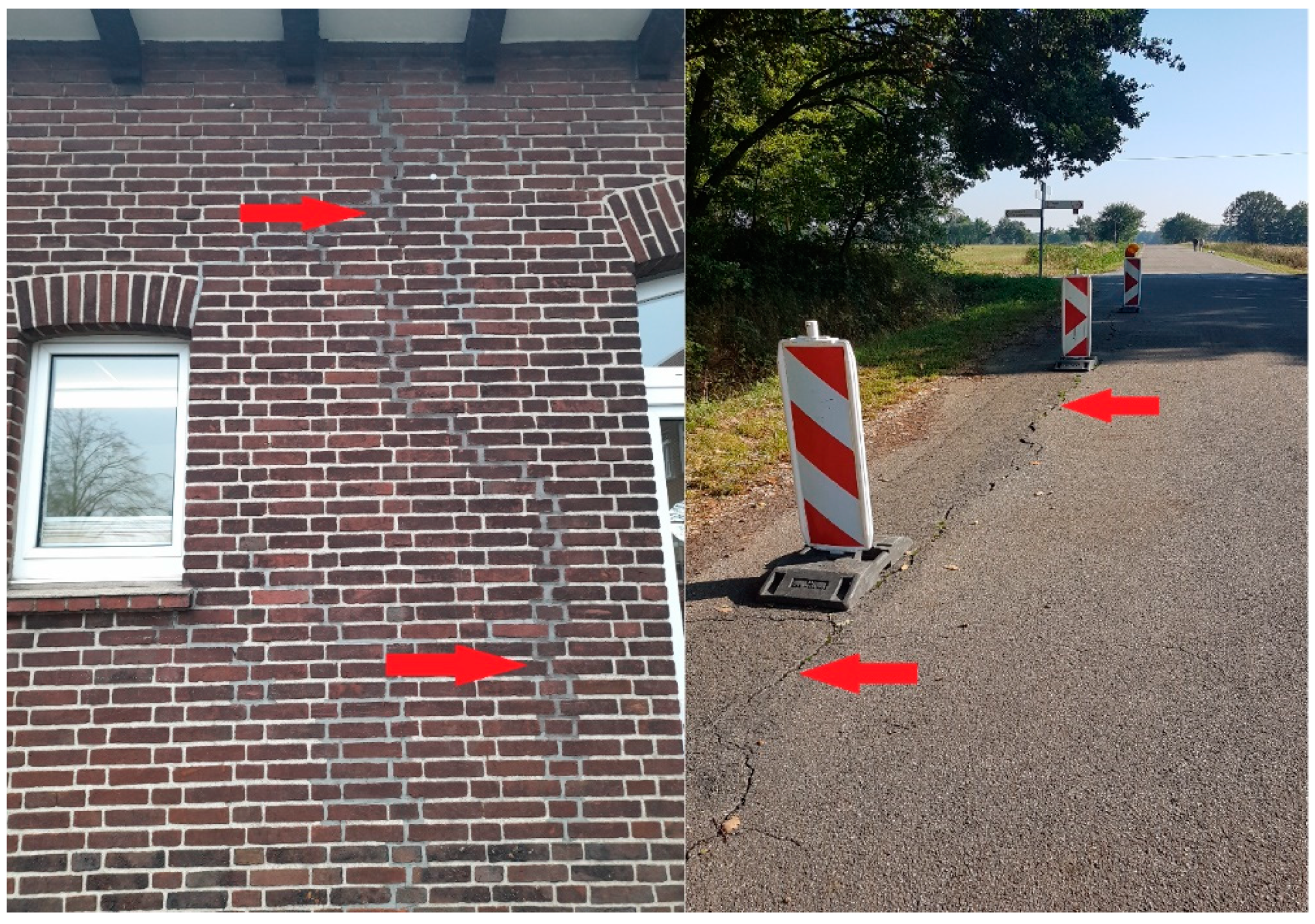
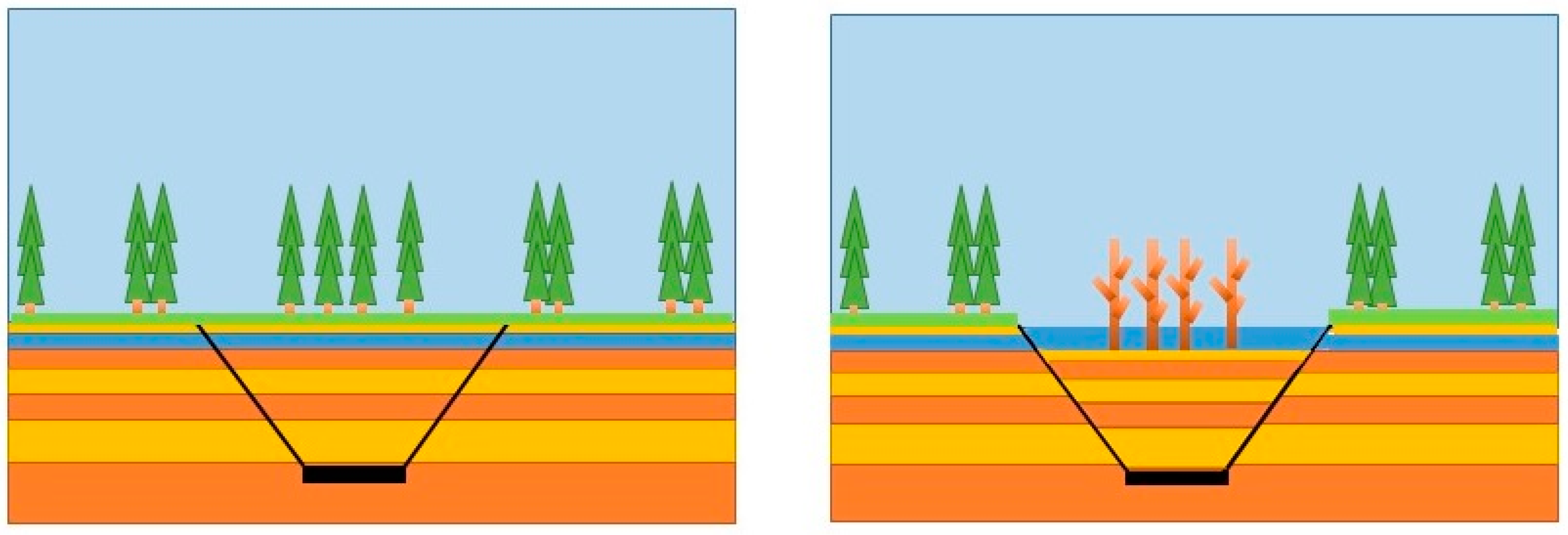
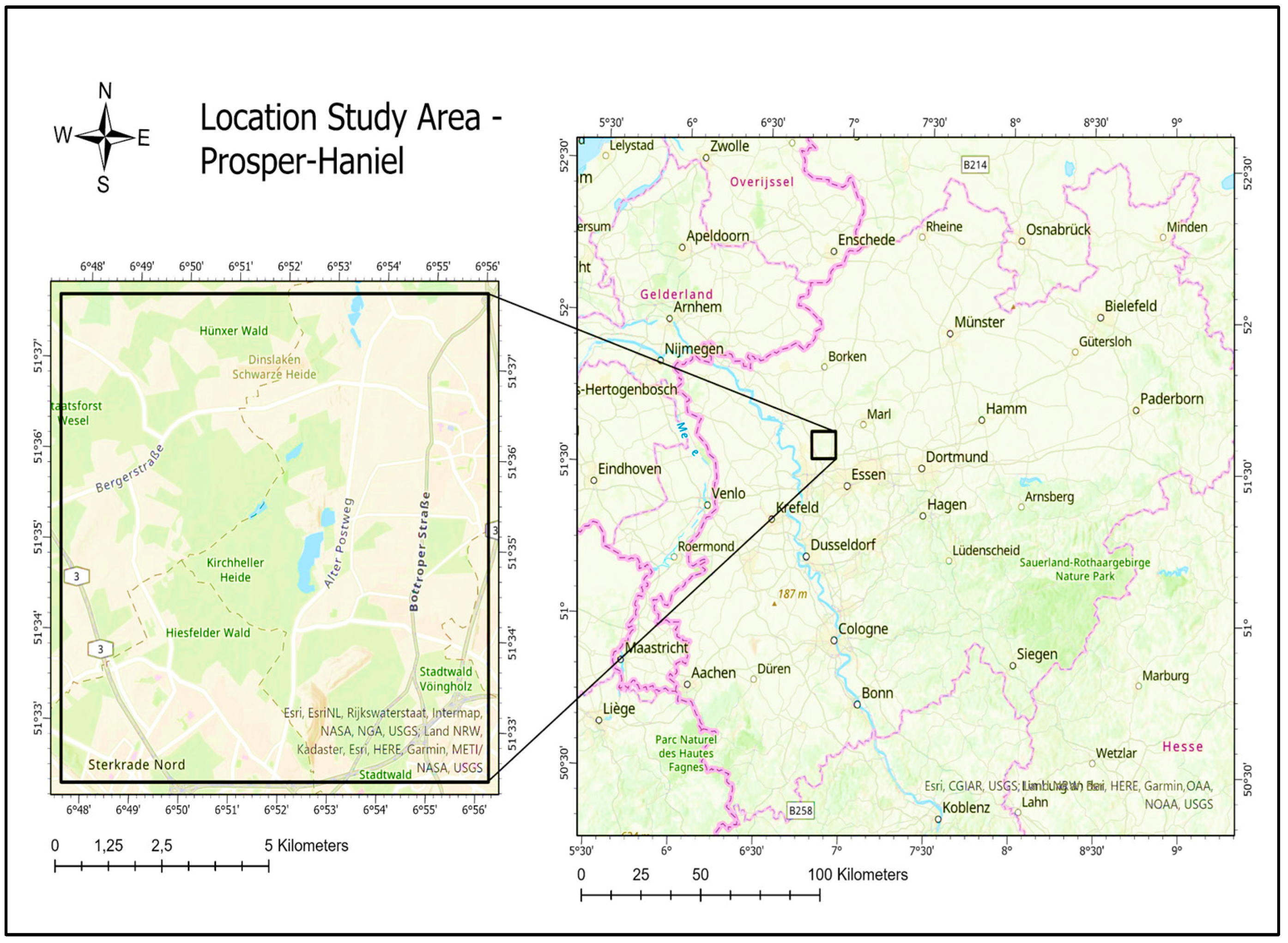
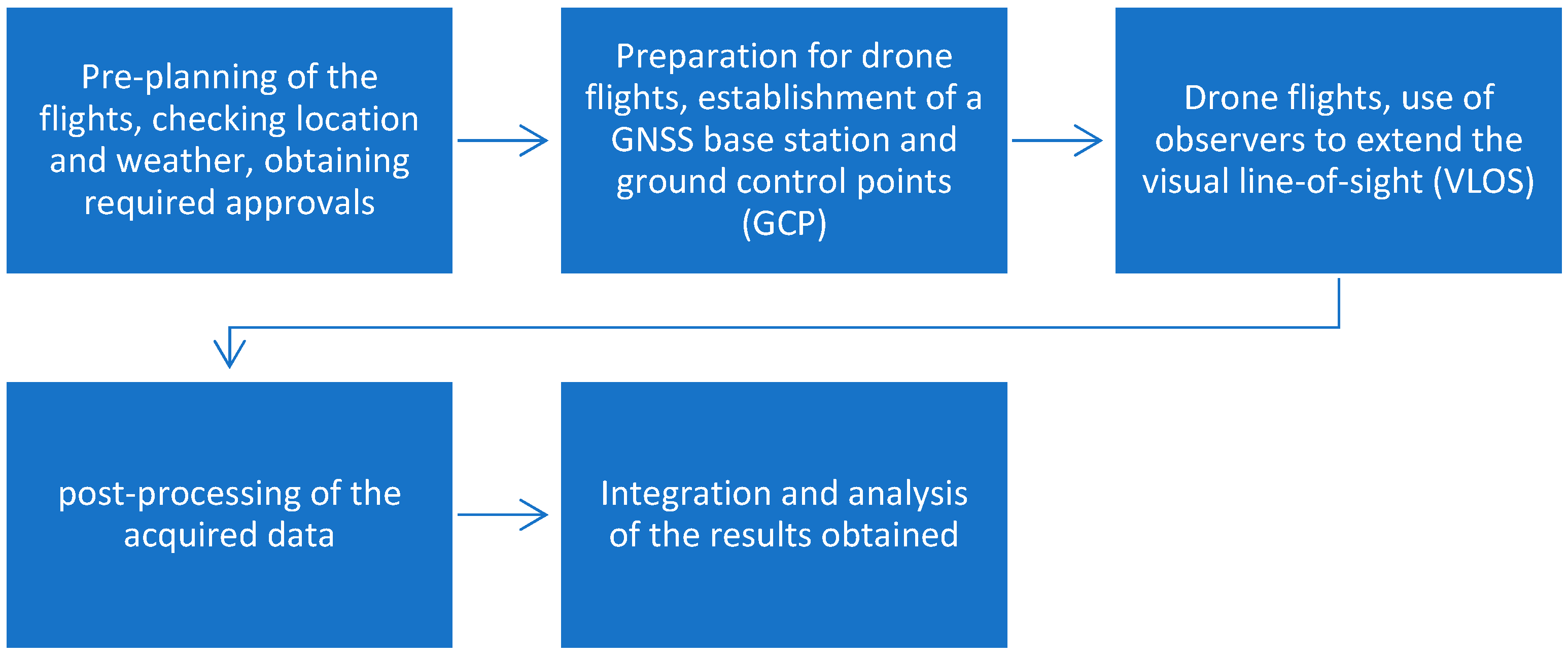
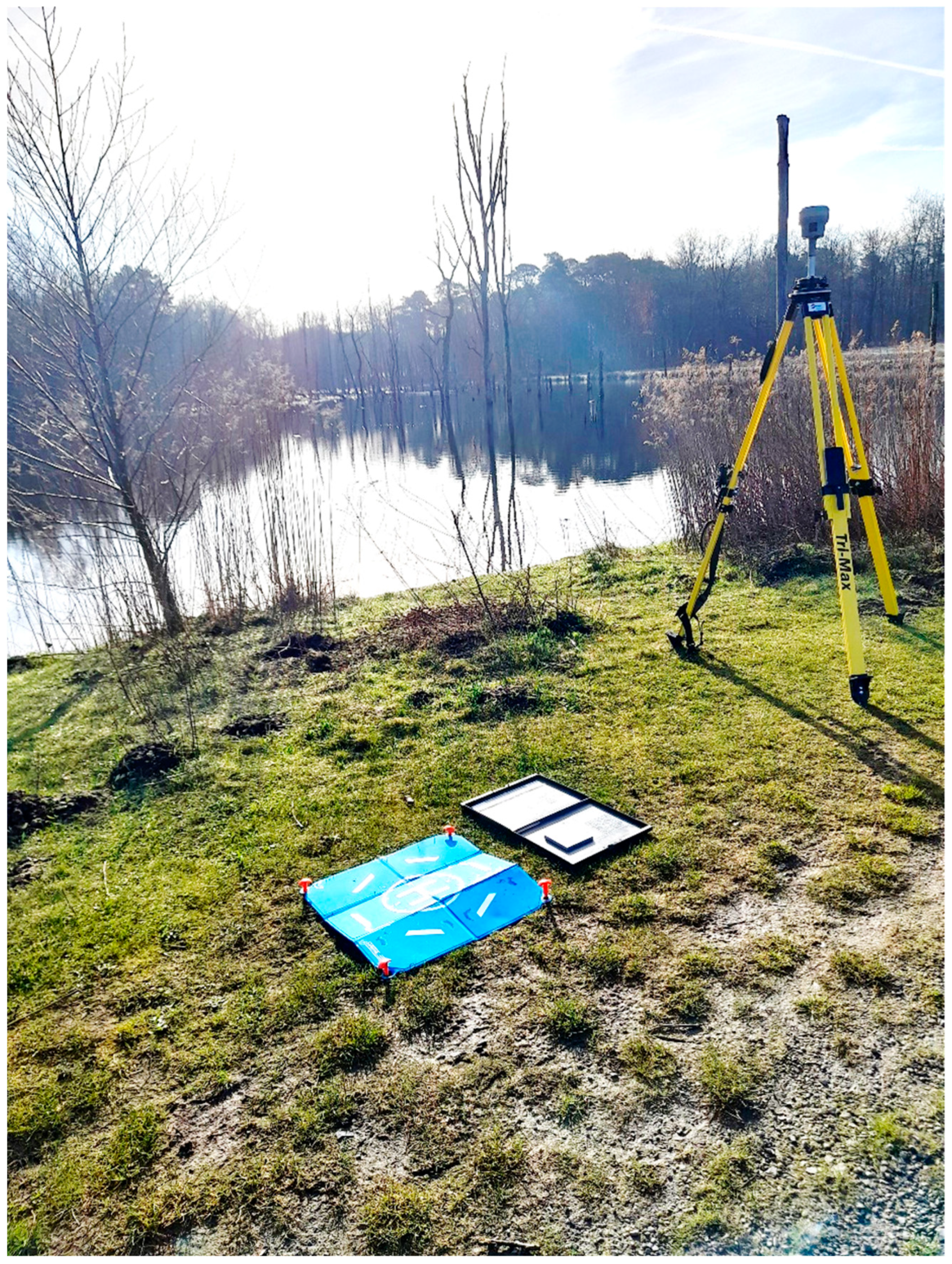
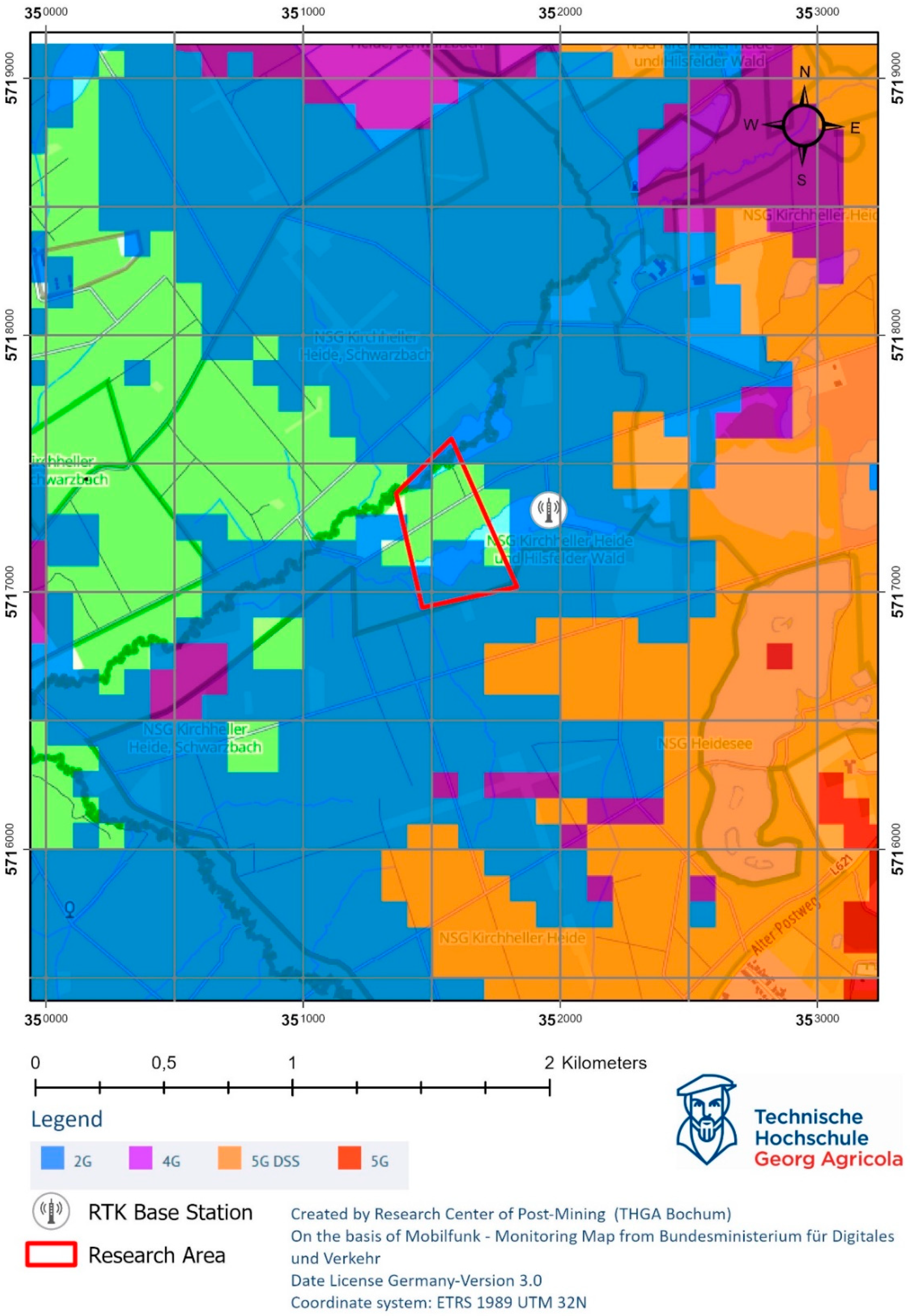
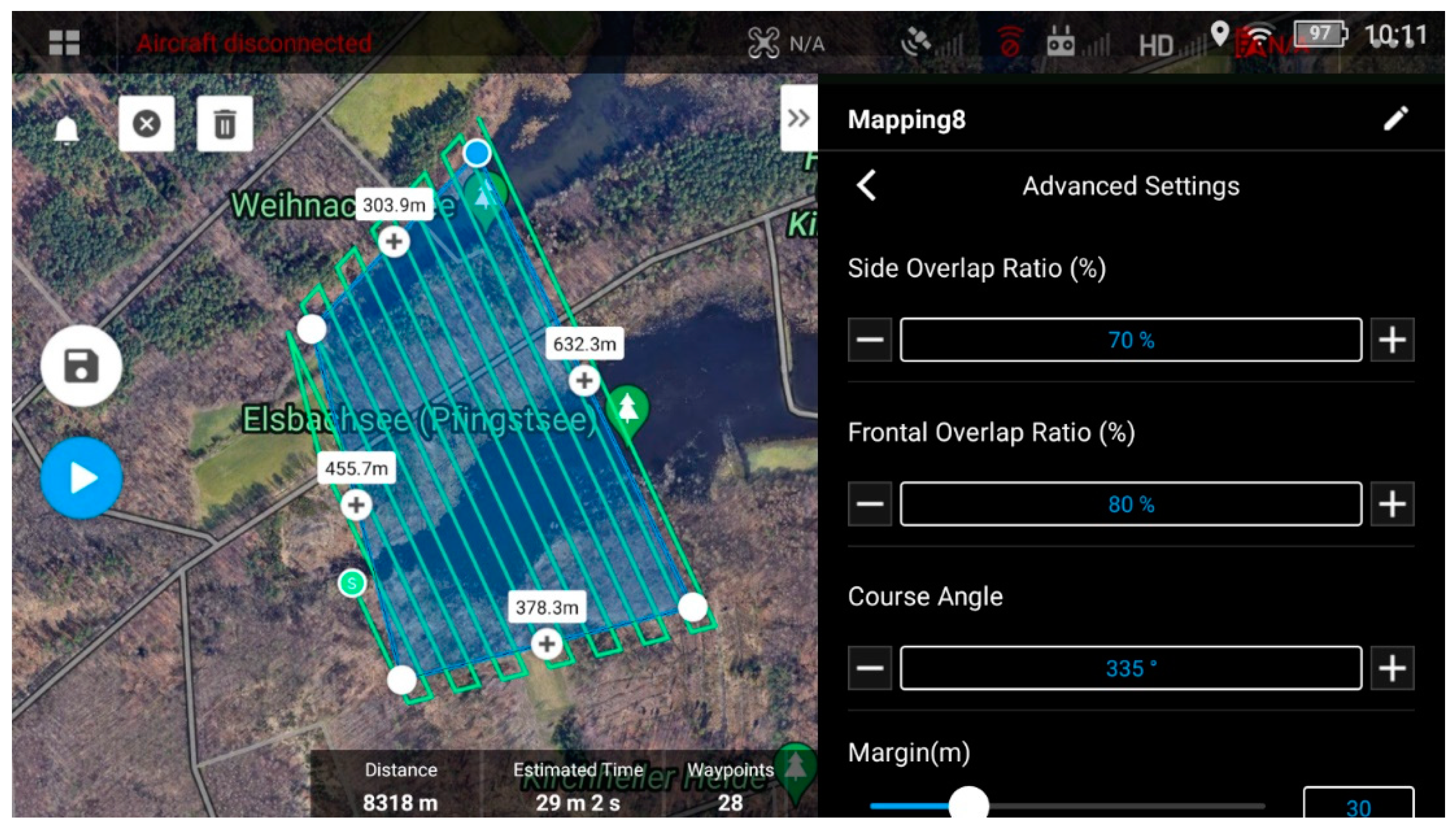
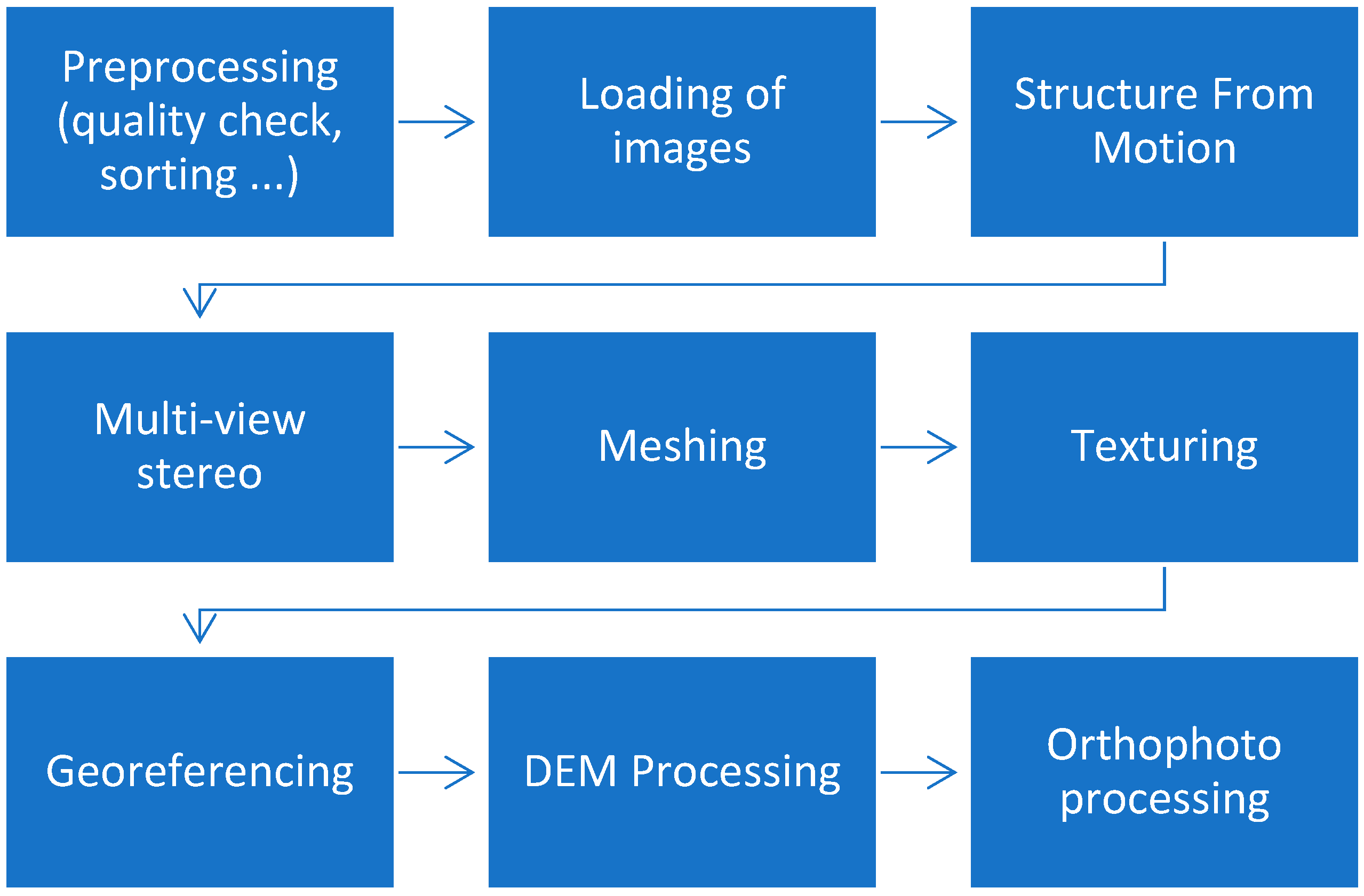
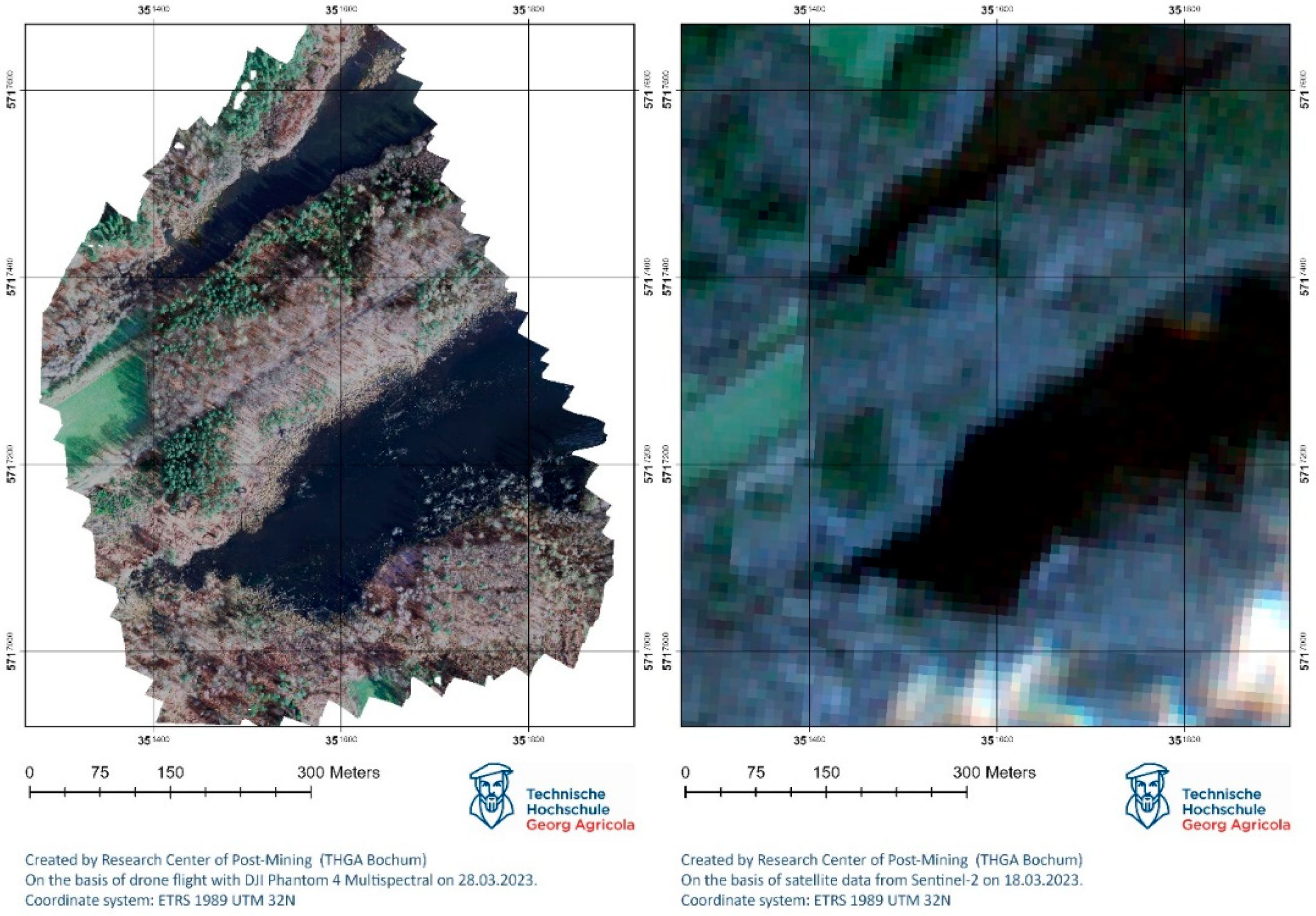
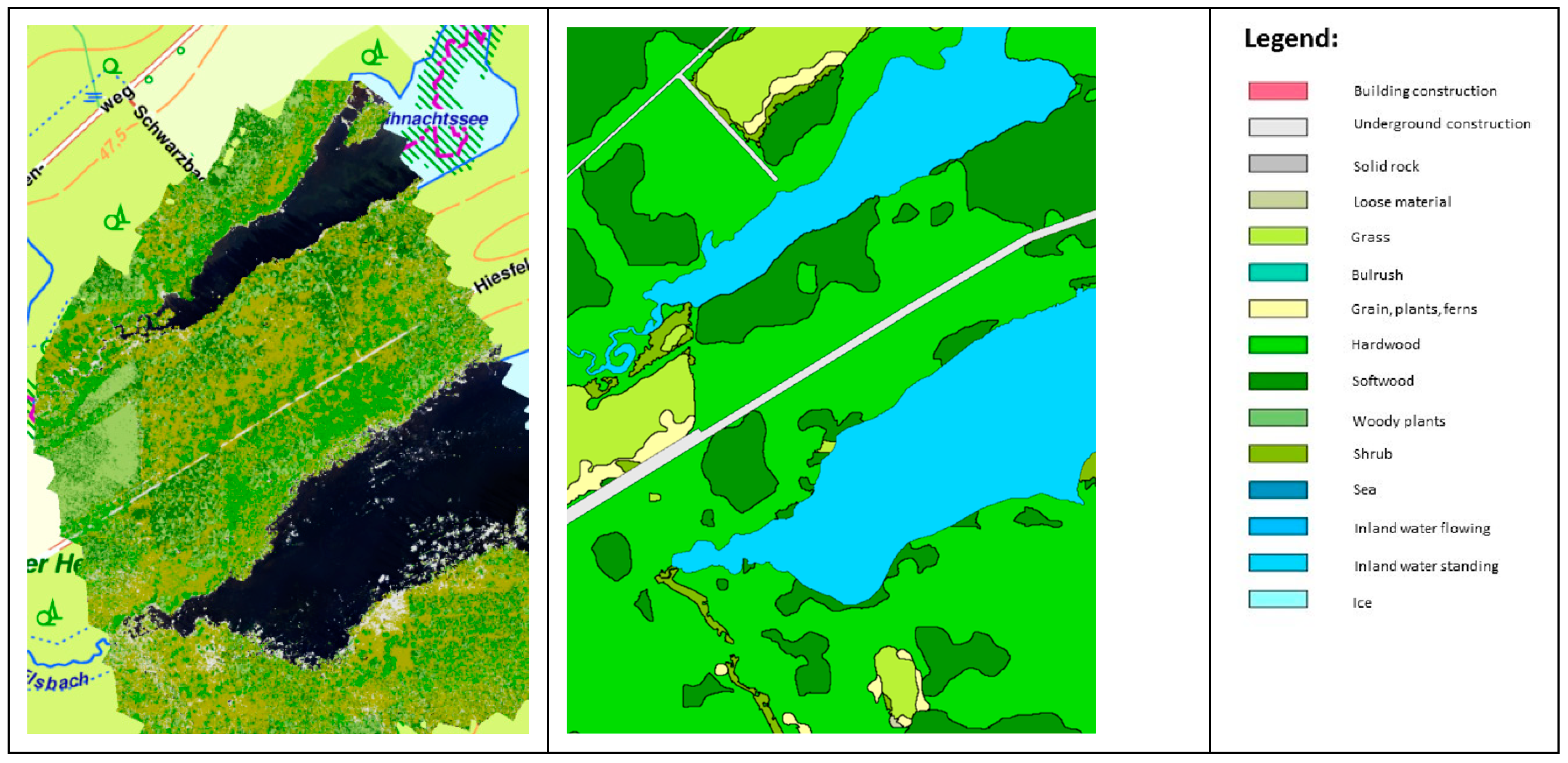
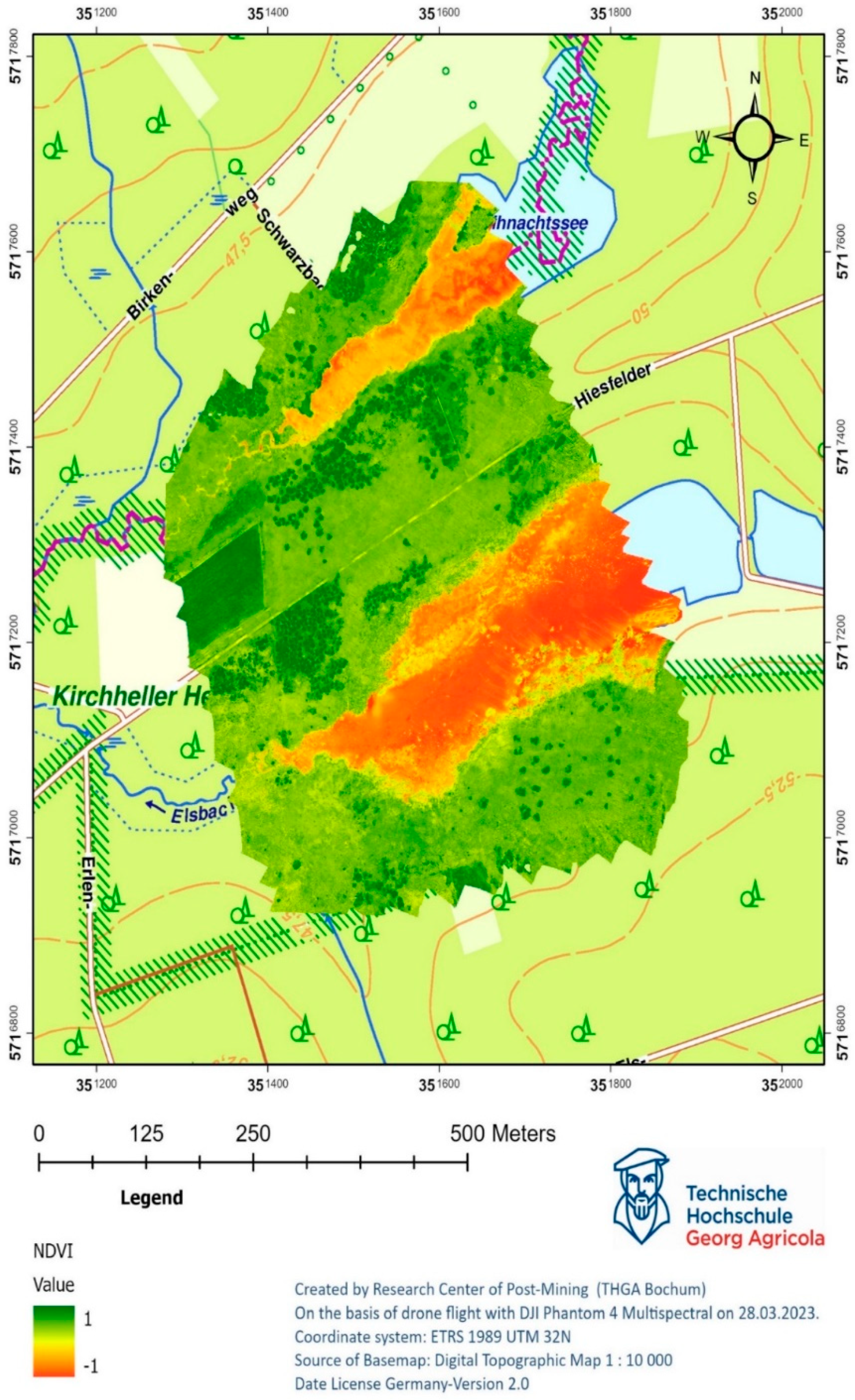
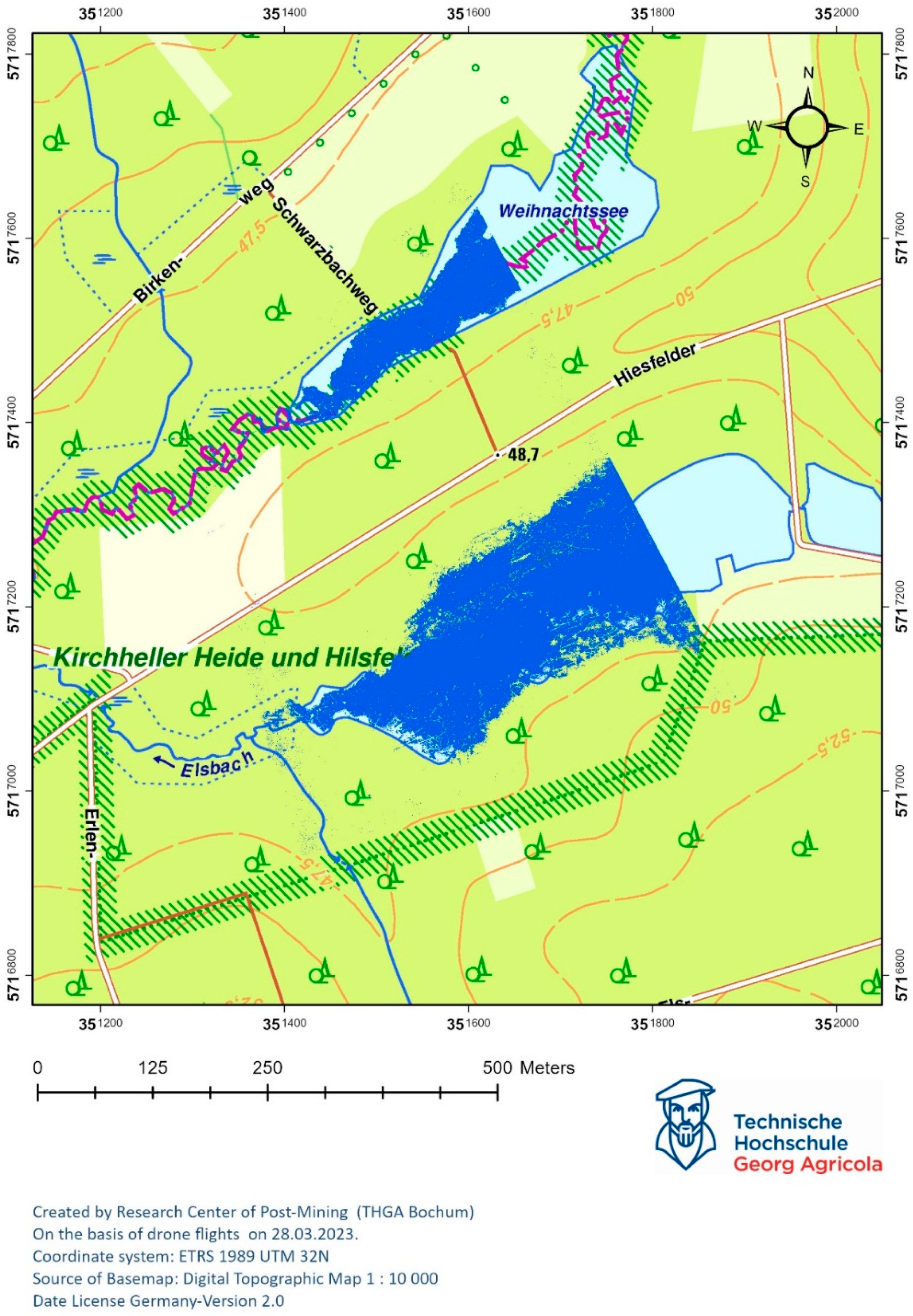
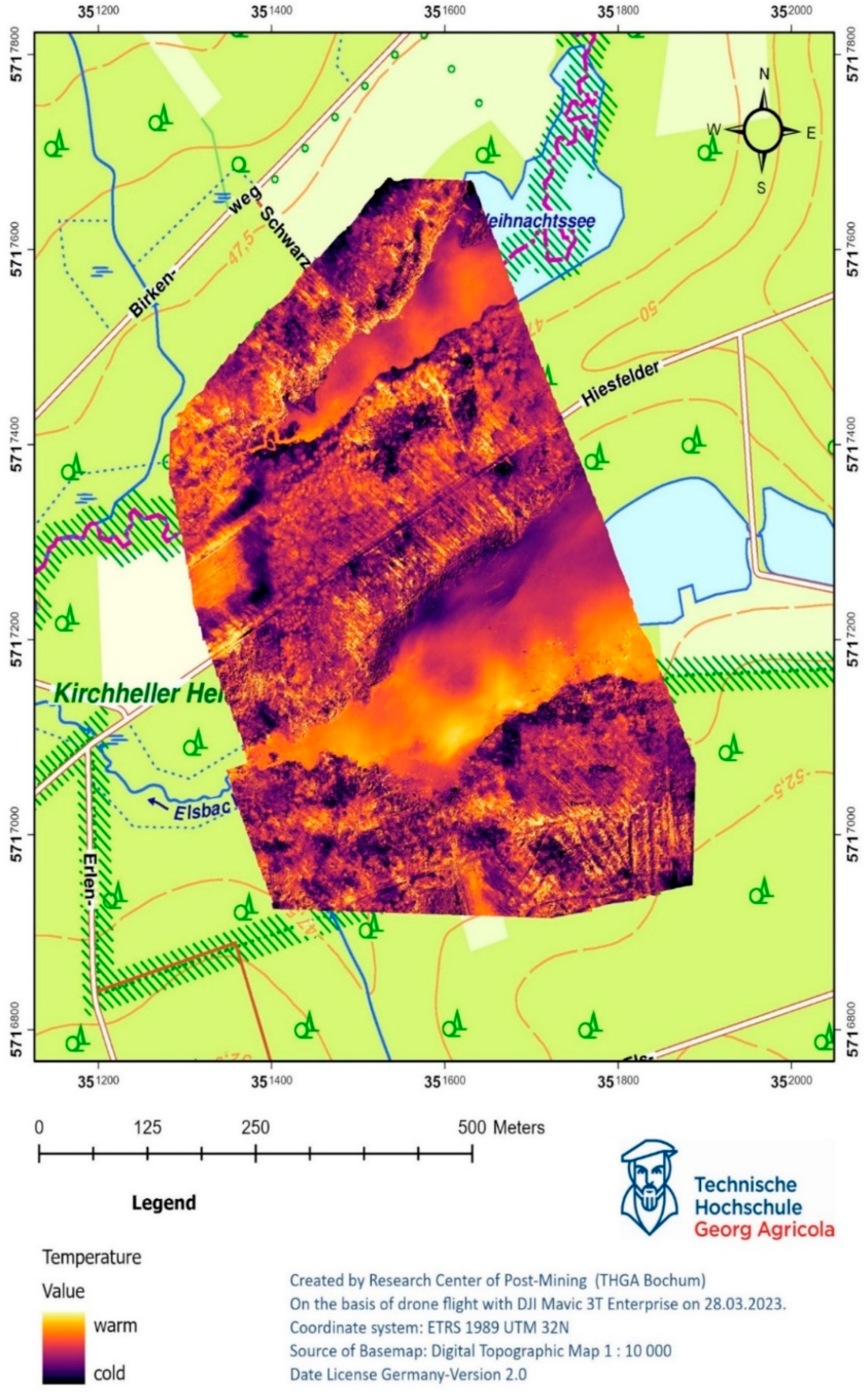
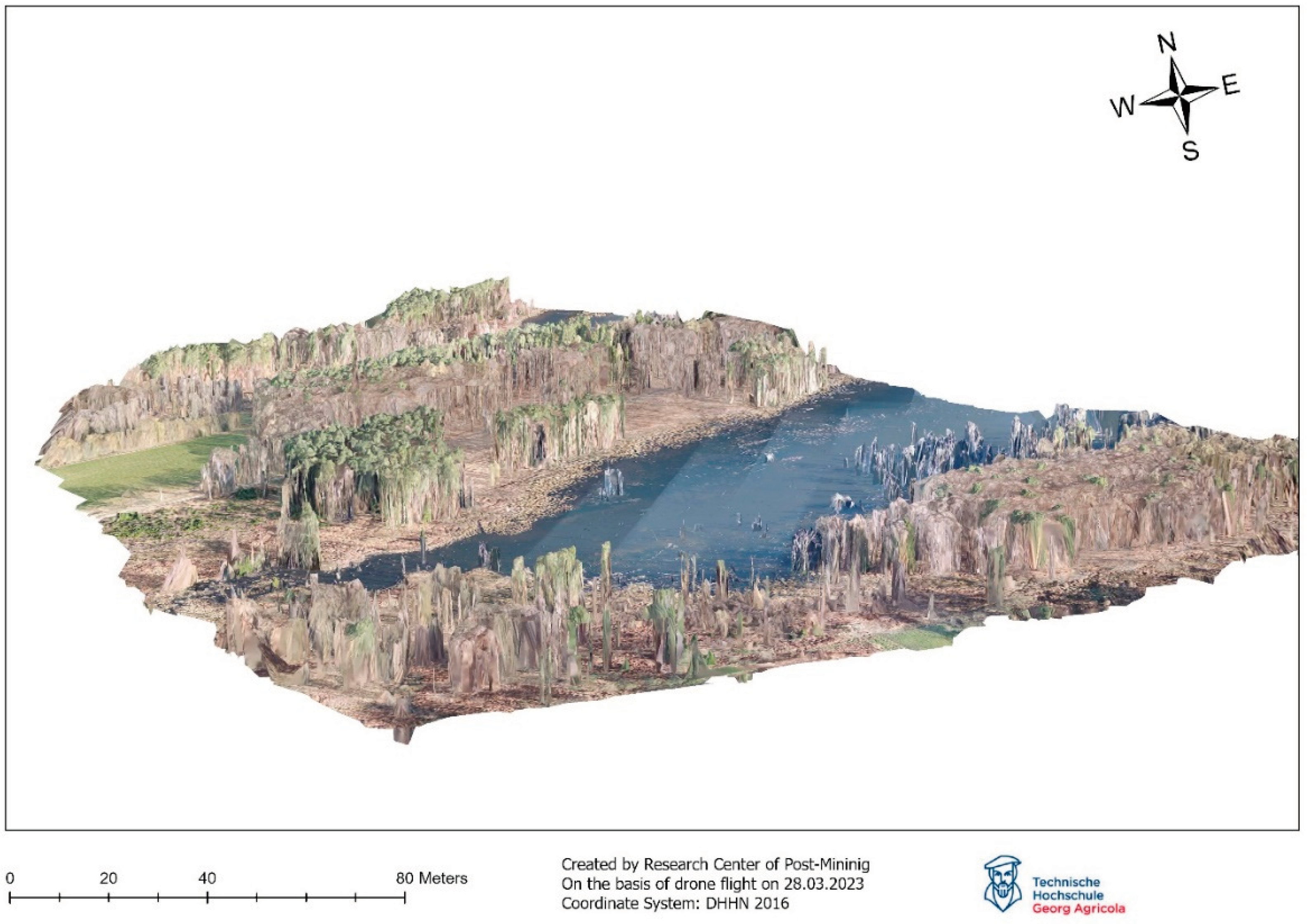
| Spectral bands | Wavelength (nm) |
|---|---|
| Blue | 434-466 |
| Green | 544-576 |
| Red | 634-666 |
| Red-Edge | 714-746 |
| Near-Infrared | 814-866 |
| Drone flight parameters | Description | Reference |
|---|---|---|
| Altitude of flight | The maximum flight height is 120 meters above the earth’s surface. It depends on whether the National Aviation Authority imposes a geographical zone with a lower limit in the area where you are flying. | [103] |
| Frontal and Side overlap | “The amount of overlap between frames in the forward and lateral direction from the perspective of the platform’s direction of movement — must be properly handled to create seamless mosaics that represent the location of the features in the image. To produce accurate terrain models, a minimum forward overlap of 80 percent and a minimum side overlap of 75 percent are recommended to maximize the number of observations of landscape features.” | [104] |
| Waypoints | Number of images taken. | |
| Estimated time | Time required to carry out a drone raid. The value is needed to estimate the number of inter-landings and take-offs. |
| Values of the NDVI | Land cover types | Color |
|---|---|---|
| <0,1 | Waters, soils, rocks, sand or snow | Red |
| 0,2 to 0,3 | Vegetation of low vitality | Yellow |
| 0,3 to 0,6 | Medium to dense vegetation cover | Light green |
| >0,6 | Very dense vegetation of high vitality | Dark green |
Disclaimer/Publisher’s Note: The statements, opinions and data contained in all publications are solely those of the individual author(s) and contributor(s) and not of MDPI and/or the editor(s). MDPI and/or the editor(s) disclaim responsibility for any injury to people or property resulting from any ideas, methods, instructions or products referred to in the content. |
© 2024 by the authors. Licensee MDPI, Basel, Switzerland. This article is an open access article distributed under the terms and conditions of the Creative Commons Attribution (CC BY) license (http://creativecommons.org/licenses/by/4.0/).





